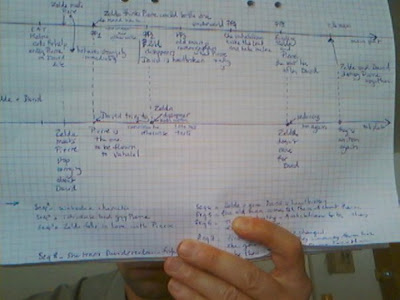*****
Every story can be roughly sliced into three distinctive parts.
1: the premise, where you set your characters and their predicament.
2: the development, where you characters struggle to fix their predicament.
3: the ending, where the characters and their predicament reach a satisfying conclusion.
When you’re initially thinking of your story, you’re probably thinking of “1”, the premise.
What if a guy realizes the world is a virtual reality called the Matrix.
What if a man wakes up one morning morphed into a beetle.
What if a group of friends are stalked and hunted down by a deformed killer with a chainsaw
Most of the times, you also have a very clear idea of “3”, the ending
The guy overcomes the Matrix and brings back humanity to reality
The man turned beetle succumbs to his wounds and starvation
Only one of the victims, Sally, escapes the chainsaw killer and survives.
When you start slicing your story, “1” and “3” always come easily. They’re also the easiest part to write. They’re short, effective and intuitive:
1: Here’s my characters and here is their problem
3: Here’s how they solve their problem and how they will live their lives from now on.
“2” is the tough nut to crack and the one you can not afford to ignore when getting ready to write your story.
“2” is longer, harder and less predictable than the beginning and the end of your story. It’s where most writers will get lost and/or give up.
But you won’t give up, right? Because your story is absolutely great and it needs to be told.
So here is the trick: you need to map “2” very precisely before you start writing. You need to sit down with a pen and a piece of paper and list all the events that will make the guts of your story. You need to work on that list until you have enough material in there to make a full length story. Oh, and don’t worry about the emotional and abstract stuff at this stage, we will come to that later.
Keep it down to basic actions and events listed chronologically, so your list looks something like this:
- Kirk and Pam stumble upon a house near their homestead
- Kirk calls out, asking for gas, while Pam waits on the front steps.
- Kirk receives no answer but when he discovers the door is unlocked, he enters the house.
- Pam gets impaled on a meathook.
- At sunset, Jerry, Sally's boyfriend, heads out to look for Pam and Kirk.
- He finds the couple's blanket outside the nearby house. He investigates and finds Pam inside a freezer. Before he can react, Leatherface murders him and stuffs him in the freezer with Pam.
- With darkness falling, Sally and Franklin set out to find their friends.
- As they near the neighboring house and call out, Leatherface lunges from the darkness and kills Franklin with a chainsaw. - Sally escapes to the house and finds the desiccated remains of an elderly couple in an upstairs room.
- She escapes from Leatherface by jumping through a second floor window and flees to the gas station. Leatherface disappears into the night.
- The proprietor of the gas station calms her with offers of help, but then ties her up and forces her into his truck.
- He drives to the house.
- They bound and gag Sally, while Leatherface, now dressed as a woman, serves dinner. Leatherface and his brother bring an old man from upstairs to join the meal.
- During the night, they decide Sally should be killed by "Grandpa", who once worked at a slaughterhouse. "Grandpa" tries to hit Sally with a hammer, but he is too weak. In the confusion, Sally breaks free.
As you can see, “2” needs a lot of meat.









